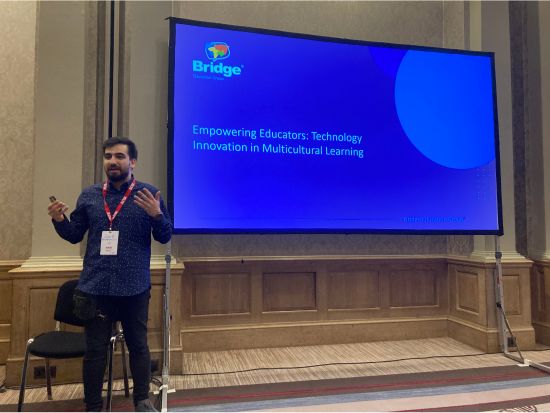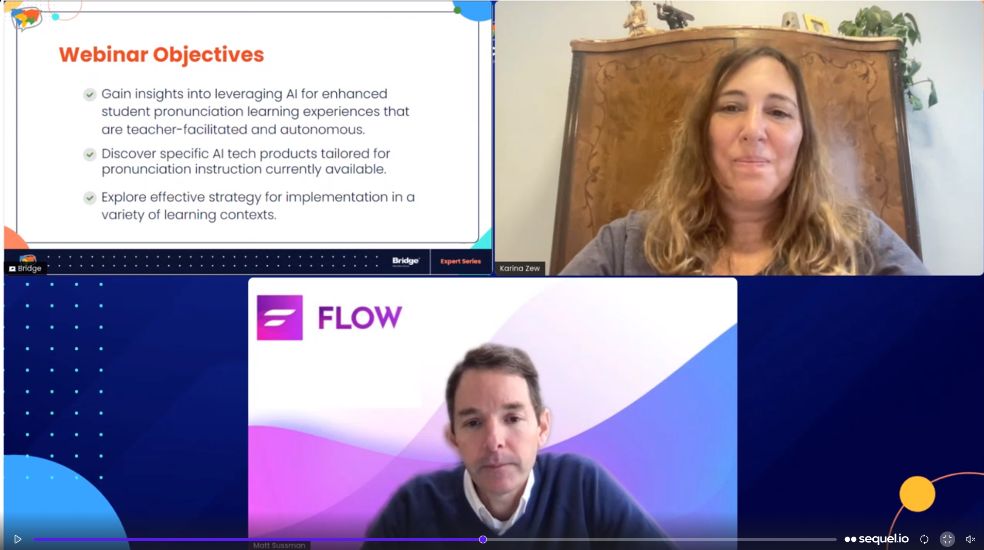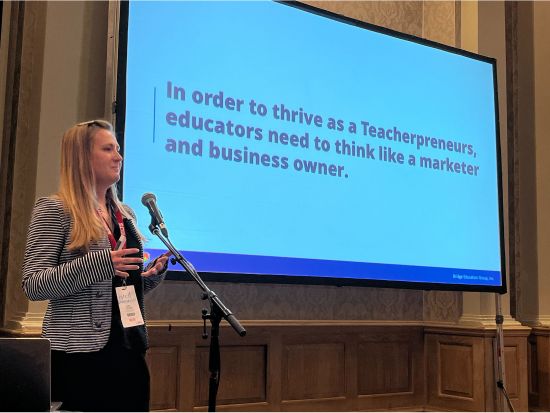As the use of AI and other technologies in English language teaching continues to expand, so do the discussions around the opportunities it brings and the ELT community’s discussions regarding its implications. So, it’s no surprise technology was a hot topic of the 57th IATEFL Conference, held from April 16 to 19, at The Brighton Centre in Brighton, UK.
Attended by English language teaching professionals from over 100 countries, this year’s IATEFL Conference featured plenary sessions, presentations, workshops, exhibitions, and forums on a variety of themes, from materials development to assessment to teaching niches like Business English and English proficiency test prep.
Bridge took part in this year’s conference, with presentations by Anna Hearrell, Director of Operations, Karina Zew, Academic Director, and Umut Ergöz, Academic Operations Coordinator, sharing their insights on corporate language training, teacherprenurship, and tech innovations in language learning.
Interested in training for a TEFL niche? Explore Bridge’s Specialized Certifications and Micro-credential courses!

Leveraging AI and other technology in ELT
AI has come a long way from being a buzzword to becoming a practical complement to language learning and a powerful aid for English teachers. For one, it has helped teachers encourage learning autonomy, such as when teachers recommend students use language apps to practice English after class. On top of that, using AI-powered tools increases a teacher’s efficiency when assessing students’ needs and creating lesson plans and other class materials.
Because of the assistance AI can provide, staying up to date with AI and the latest digital tools has become beneficial for English teachers. It helps them to stay on top of their game, especially when it comes to addressing special learner needs and catering to specific niches. Teaching Business English, for instance, is a specialization that can leverage AI tools in many different ways, including by:
-
personalizing learning paths
-
carrying out placement tests through adaptive learning platforms
-
customizing class content and assessment
-
personalizing learners’ extended practice exercises
Throughout the IATEFL Conference, the use of AI and tech innovations were widely discussed, as various educators delved into topics such as the teacher’s role in using AI, selecting online tools, how AI can be used for teaching various English skills, and creating digital class activities.
Sharing his insights on this topic, Ergöz talked about how tech-driven strategies are transforming multicultural language learning and how Business English trainers can leverage AI’s capabilities.
“With the advancement of AI and its integration into various fields, it’s crucial to recognize both its capabilities and limitations,” he said, sharing why he chose to present on this topic at IATEFL. “I wanted to underscore this point. Technology serves as a powerful tool for Business English learners, particularly addressing one of the main challenges adult learners face: time constraints. Adult learners often juggle busy schedules, making it difficult to maintain consistent learning patterns. One day may be filled with meetings, while another offers free time. Technology can adapt to these varying schedules and support flexible learning opportunities.”
In his presentation, Ergöz first tackled the challenges of teaching and learning Business English, challenges that range from learners’ time constraints to their specific language needs. Then, he asked the audience to think about the popularity of language learning apps.
“During my presentation, I asked how many in the audience had a language learning app on their phones and it was quite a big number,” he said. “Then I asked them how many of them learned a language using one of those apps and the answer was zero! Absolutely no one! I wanted the audience to understand why this is happening and how we are dealing with it at Bridge Corporate Language Learning, by putting our teachers at the center of our teaching methodology.”
Sharing data regarding language learning apps and how teachers can leverage technology tools also sparked curiosity among the audience. “The reaction was marvelous!” Ergöz said. “Many photos and notes were taken, especially regarding the tools I mentioned. It made me think that while technology is readily available, it can also present challenges. Finding helpful tools and incorporating them into your teaching methodology can be tricky, especially if you are not from the new generation of teachers who were born with computers and smartphones in hand.”
Finally, Ergöz also talked about the advantages of using AI tools in supporting Business English students’ learning. As Bridge Corporate Language Learning itself makes the most out of AI to enhance its corporate language courses, its teachers use a variety of tech tools to carry out student placement, map out lesson plans based on student needs, and provide learners with avenues to practice English even outside their classes. But while tech tools and apps improve language instruction, Ergöz highlighted that they can never replace the teacher’s role.
“The main idea was that technology and AI could be used for many different things, especially outside of the classroom, but still, the teacher is the heart of education,” he said. “I wanted to show that to the audience. Having technology is truly helpful, especially for asynchronous learning, but still, we should always consider the human factor. I’m a strong believer that technology and teachers can go hand in hand when it comes to Business English teaching!”
Read more about ways to hyper-personalize your Business English teaching with AI.

Additional IATEFL highlights
Aside from technology, the sessions at the IATEFL Conference covered other topics, such as teaching methodologies, professional development, ELT teacher training, Content and Language Integrated Learning (CLIL), and language testing and assessment.
In her presentation, Hearrell gave a talk on teacherpreneurship, wherein she shared how English teachers can become independent and develop an entrepreneurial mindset.
“I chose to present on teacherpreneurism because I think that running an independent teaching business (of whatever size) is doable for any English teacher who sets their mind to it or realizes it’s a path they want to explore,” she shared. “It is a journey to success, but I tried to highlight that in my presentation by giving teachers examples of pathways and cases where other teachers have worked to build a business and brand behind their teaching services.”
At the start of her presentation, Hearrell pointed out that not many people are still unfamiliar with the concept of being a teacherpreneur, saying, “Within our industry, the phenomenon of an English teacher working to have their own portfolio of private students is not new; in the past it has been referred to as independent teaching or maybe even freelance teaching. However, I love the word “teacherpreneur” because I think it’s incredibly powerful. And, it leans into what teachers often struggle with the most: business and marketing practices.”
Along with introducing the meaning of teacherpreneur and its advantages, she also gave tips on how English teachers can successfully launch their teaching business, from choosing a niche to defining their product offers to creating their Unique Selling Proposition (USP).
“I hope that educators feel motivated and empowered; I hope that they realize that they have inherent traits as educators that can translate to a more business-forward mentality,” Hearrell said. “By becoming a teacherpreneur, they’re finally also advocating for themselves and stepping up to get what they need or deserve out of a teaching job – which I fully support!”
Ready to launch or expand an independent teaching career? Learn more about Teacherpreneur Academy, which provides training, resources, and support for independent English teachers.

Building networks through IATEFL
Aside from learning and gaining fresh perspectives from industry experts, the IATEFL Conference also allowed attendees to meet and connect with other ELT professionals or strengthen relationships with those whom they had met in previous conferences. For Ergöz, the networking aspect of the event, being able to build global connections, was the most exciting part.
“I met so many interesting people and built great connections,” he said. “It also allowed me to realize how much there is to learn about education and teaching. I even met some important linguists whose books I’ve read! Learning, sharing ideas, and growing was so much fun. Representing Bridge Education, which I love and consider my second home, was such an honor!”
Hearrell similarly found the experience enjoyable. “IATEFL is always a great time! From chatting with old friends to meeting new contacts, it’s often the time of the year I feel most connected to our industry and its key players,” she said. “The atmosphere is always full of people who want to learn, whether it be new teaching skills, about innovative products or technologies, or to simply learn about you and your background – there’s no shortage of motivation to continue professional development.”
From staying abreast of current trends or interacting with educators around the world, the IATEFL Conference provides a chance for the ELT community to stay connected, keep learning together, and support each other. If you’re an educator in the English teaching field, make sure that the next IATEFL Conference is on your bucket list so that you too can continue growing and adapting to the ever-evolving English teaching field!







